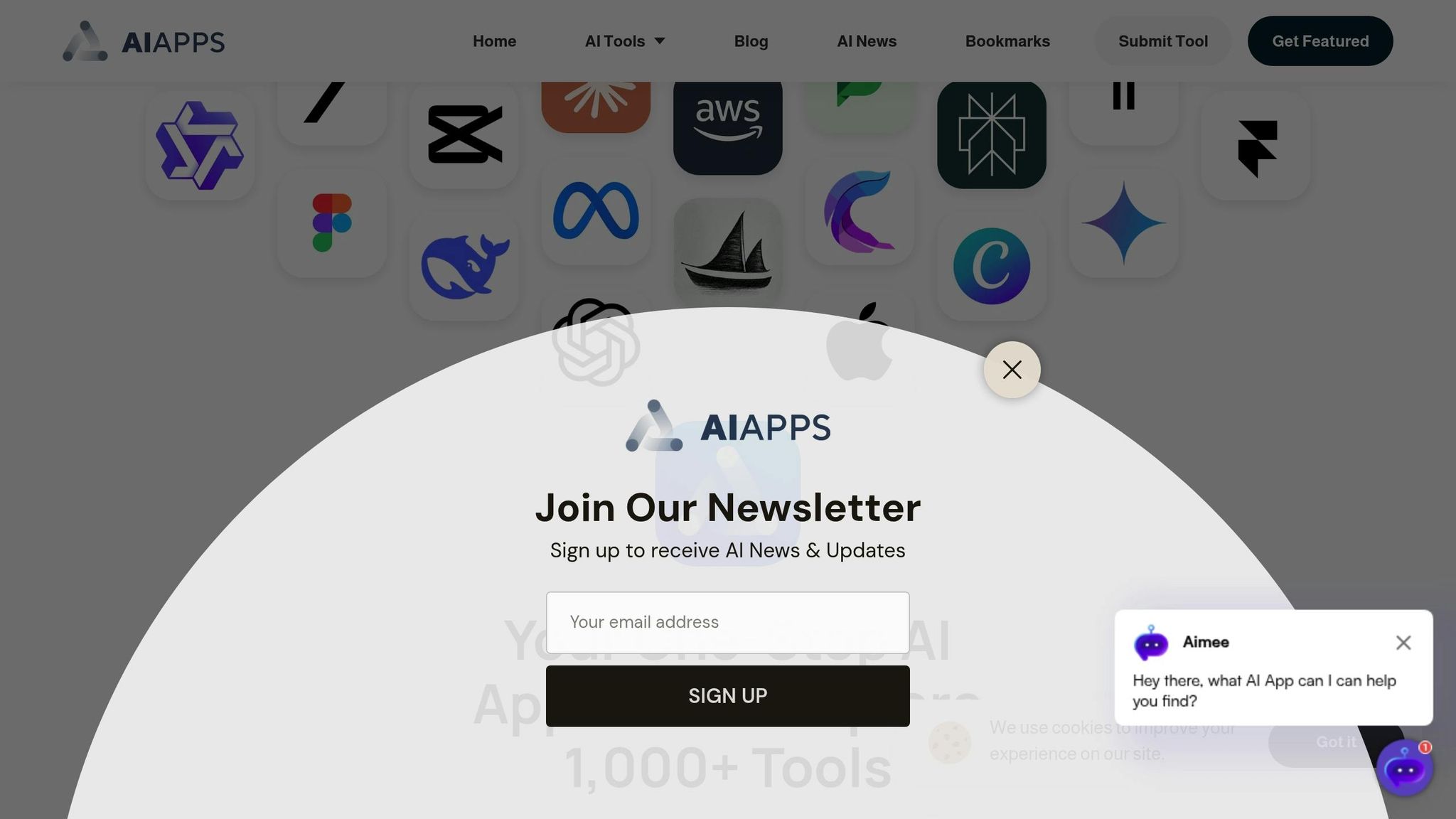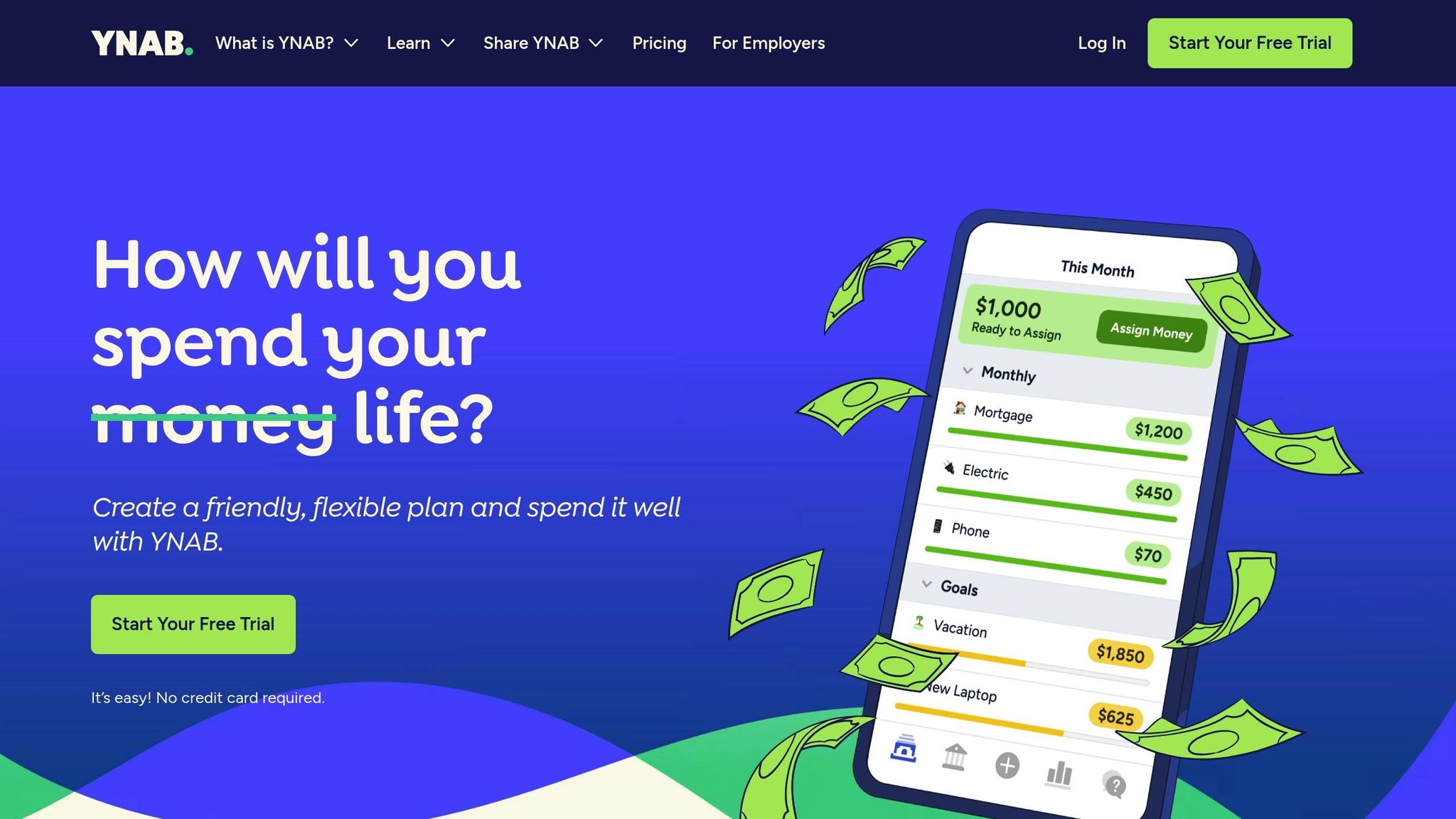Managing your finances doesn’t have to be stressful anymore. AI-powered budgeting tools can help you track expenses, plan for the future, and save more effectively. Here’s a quick look at four standout options:
- AI Apps: A free directory to discover over 1,000 AI tools, including expense trackers, forecasting solutions, and savings optimizers.
- Cleo: A chatbot-driven app that combines smart financial tracking with fun, engaging insights. Free to start, with premium plans from $2.99/month.
- You Need a Budget (YNAB): A zero-based budgeting tool focused on assigning every dollar a purpose. Costs $14.99/month or $109/year.
- Personal Capital: Now called Empower, it blends expense tracking with investment and retirement planning. Basic tools are free; wealth management costs 0.89% of managed assets.
Quick Comparison:
| Tool | Free Version | Premium Pricing | Best For |
|---|---|---|---|
| AI Apps | Yes | Freemium (optional ads) | Discovering various AI tools |
| Cleo | Yes | $2.99–$14.99/month | Casual budgeters |
| YNAB | No | $14.99/month or $109/yr | Hands-on, zero-based budgeting |
| Personal Capital | Yes | 0.89% of managed assets | Investment and retirement planning |
These tools cater to different needs, whether you want simple tracking, detailed budgeting, or long-term financial planning. Choose the one that aligns with your goals.
You’re Wasting Money by Not Using AI to Budget (2025 Update)
1. AI Apps

AI Apps serves as a go-to hub for discovering over 1,000 AI tools, including solutions designed to help users manage their finances effectively. While it’s primarily known as a discovery platform, it stands out by offering a carefully curated directory of AI-powered budgeting tools.
The platform organizes budgeting tools by function, making it easy for users to find the right solution for their specific financial needs. Here are the three main areas where AI Apps shines:
Expense Tracking
AI Apps simplifies the search for AI-driven expense tracking tools, which use machine learning to categorize transactions, analyze spending habits, and deliver real-time insights. Only tools that pass a rigorous verification process make it to the directory, ensuring users can trust the quality of their selections. Whether you’re managing personal or business expenses, the platform offers filtering options to match your budget and requirements. Additionally, AI Apps connects users to tools that combine expense tracking with powerful forecasting capabilities.
Financial Forecasting
For those looking to improve prediction accuracy, AI Apps provides access to top-tier financial forecasting tools. According to IBM research, businesses leveraging AI for budgeting and forecasting have reduced errors by at least 20%. These tools analyze complex data sets to deliver precise forecasts and enable real-time adjustments to budgets, making them invaluable for both personal and professional use.
Savings Optimization
The platform also highlights AI tools designed to help users optimize their savings strategies. These solutions analyze spending patterns, process large amounts of financial data, and offer automated recommendations tailored to individual goals. By focusing on measurable outcomes, these tools empower users to maximize their savings potential.
Pricing
AI Apps makes budgeting tool discovery accessible with its freemium pricing model. Users can browse the entire directory for free, gaining insights into each tool’s features and pricing. For developers, the platform offers paid featured listing options that boost visibility, such as homepage placement. This keeps the core service free for users while providing additional promotional opportunities for developers.
2. Cleo

Cleo is an AI-powered budgeting app that combines smart financial tracking with a chatbot full of personality. With over 1 million downloads and a stellar 4.8-star rating on the App Store, it has become a go-to tool for making money management both practical and engaging. So, what sets Cleo apart? Let’s dive into its standout features.
As Emma Ginsberg from The Everygirl puts it:
"The thing that truly makes this AI‑powered budgeting app different from any other old budgeting app is the chat feature... the real magic happens when you ask Cleo to either 'hype' you or 'roast' you."
Cleo’s AI doesn’t just track your spending - it interprets it, offering insights that feel more like advice from a witty, financially savvy friend than dry banking alerts.
Expense Tracking
Cleo’s AI is great at automatically categorizing your spending. Its "habits" section allows you to rate your purchases, helping you separate worthwhile expenses from those you might regret. The app also sends weekly and weekend notifications to encourage spending reviews and goal-setting. In 2023, Cleo helped users avoid nearly two million declined transactions or overdrafts by flagging upcoming bills and recurring costs. Impressively, 85% of users reported cutting back on spending and saving more.
Beyond tracking, Cleo delivers personalized tips and reminders to help you stay within your budget, making it easier to keep your finances in check.
Savings Features
Cleo takes the guesswork out of saving. By analyzing your spending habits, it automatically transfers a set amount from your checking account to savings. It even uses a clever "fines" system to encourage better habits - triggering small savings whenever you make impulsive purchases. On average, this approach has improved monthly savings by 25% for users.
The app also lets you set custom savings goals with target dates, automatically moving money into dedicated savings accounts to help you reach them. As one App Store reviewer, Amethyst, shared:
"I love the savings feature. It allows you to use hacks so that you can save and create better habits!"
Some users have even managed to save over $1,000 in just a few months thanks to these automated tools.
Pricing
Cleo operates on a freemium model, offering essential features like basic budgeting tools, expense categorization, and chatbot interactions for free. For those wanting more advanced options, Cleo offers three paid tiers:
- Cleo Grow: $2.99/month – Includes savings challenges and access to a high-yield savings account.
- Cleo Plus: $5.99/month – Adds advanced budgeting tools, enhanced savings features, and personalized financial coaching.
- Cleo Builder: $14.99/month – Offers credit-building tools through a secured credit card, along with additional financial management features.
This tiered pricing allows users to start for free and upgrade as their financial needs evolve. Whether you’re looking for simple budgeting or more robust tools, there’s a plan that can align with your goals.
3. You Need a Budget (YNAB)

You Need a Budget (YNAB) takes a modern approach to budgeting by blending zero-based budgeting with AI-driven tools. The idea is simple: every dollar you earn gets assigned a specific job, ensuring your money works toward your financial goals. Unlike apps that focus on tracking what you've already spent, YNAB emphasizes planning for how you'll use the money you currently have. This proactive method ties together expense tracking, financial planning, and savings strategies into one cohesive system.
As Adrienne So, Senior Associate Reviews Editor for WIRED, puts it:
"YNAB isn't just a tool for money management. It's a tool for self-actualization. Define your goals and let every dollar drive you closer to them."
The impact is clear: 90% of users report improved financial health, and 91% say the app has reshaped how they think about money.
Expense Tracking
YNAB simplifies expense tracking by linking directly to your bank accounts while also encouraging manual entries to help you stay mindful of your spending habits. The zero-based budgeting approach means every dollar you earn is assigned to a category as soon as it hits your account. This includes setting up sinking funds to prepare for both recurring and unexpected expenses - like car repairs or holiday shopping.
The app is built around three key principles: create a budget you can realistically follow, log transactions as they happen, and adjust your budget proactively when things change. On average, users save $600 in their first month and $6,000 in their first year.
Financial Forecasting
YNAB doesn’t just track your spending; it helps you plan for what’s ahead. Its system focuses on managing the money you currently have, rather than banking on future income that might not materialize. Founder Jesse Mecham explains:
"Budgeting is planning how you will use money that you have on-hand. Forecasting is planning how you will spend money you think you will have - you hope you will have - in the future."
Features like Scheduled Transactions and Targets make it easy to prepare for upcoming expenses and cash flow without relying on uncertain future earnings.
Savings Strategies
YNAB encourages users to prioritize savings by allocating money to savings categories before spending on non-essentials. This upfront approach keeps you actively engaged with your financial goals. The app also offers educational tools, such as live Zoom workshops, to help users refine their budgeting and savings techniques. With consistent effort, many users save an average of $6,000 within their first year.
Pricing
YNAB is a subscription-based app with no free version, but it does offer a 34-day free trial that doesn’t require a credit card if you sign up directly through their website. (Note: If you sign up via third-party app stores, you may need to provide payment details.) Pricing options include:
- Monthly Plan: $14.99 per month
- Annual Plan: $109 per year (equivalent to $9.08 per month)
There are also ways to save on the subscription. College students can enjoy a free year of access, and the referral program rewards both the referrer and the referred friend with an extra free month after the trial. Subscribers can share their account with up to five family members at no extra cost. Additionally, businesses can explore Financial Wellness by YNAB, a program designed as an employee benefit. For those upgrading from the older YNAB 4 version, a 10% lifetime discount is available. All prices are in US dollars, with no adjustments for currency exchange rates.
sbb-itb-212c9ea
4. Personal Capital
Personal Capital, now rebranded as Empower, combines tools for tracking expenses, analyzing investments, and planning for retirement. With more than 2 million users and over $12 billion in assets under management, the platform uses machine learning to categorize transactions automatically, giving users a clear and unified view of their financial accounts. This integration provides a balance between managing daily expenses and planning for long-term financial goals, making it a powerful tool for effective budgeting with AI.
Expense Tracking
The expense tracking feature organizes transactions from all linked accounts - whether checking, savings, or investments - into clear categories. This gives users a detailed overview of their finances. Considering that 61% of Americans don't actively track their spending, this tool can help identify areas of overspending and make it easier to adjust budgets and allocate resources where they’re needed most.
Financial Forecasting
Beyond tracking current finances, Personal Capital stands out for its forward-looking planning tools. The Retirement Planner, for instance, runs simulations based on various income scenarios, inflation rates, and investment returns, offering detailed projections to guide savings strategies. Additionally, the Smart Withdrawal tool helps users map out how to use their savings effectively during retirement.
PCMag highlights this focus on future planning, noting that "Personal Capital is light on personal finance tools but heavy on investment tracking and retirement planning." While it offers basic budgeting and transaction management, its standout features are its robust retirement planning tools. PCMag also emphasized that its retirement planning capabilities are more thorough and flexible than many competing services. Another key feature, the Investment Checkup, evaluates users' investment portfolios and provides tailored advice to improve performance.
Pricing
Personal Capital operates on a freemium model. Its budgeting, expense tracking, and retirement planning tools are free, but wealth management services come with an annual fee of 0.89% for the first $1 million in assets. Beyond that, fees decrease on a tiered scale: 0.79% for the next $3 million, 0.69% for the following $2 million, 0.59% for the subsequent $5 million, and 0.49% for assets over $10 million. While these fees are generally lower than those charged by traditional financial advisors, they may be higher than those of many robo-advisors. For its free tier, Personal Capital generates revenue by promoting its own financial products and services, ensuring users that their data is not sold to third parties.
Tool Comparison
When choosing a financial tool, it's essential to weigh factors like integration, pricing, features, automation, and the target audience. Each platform brings its own strengths, tailored to different user needs and budgets. Below, we break down the details to help you decide which one aligns with your financial goals.
Integration with U.S. Financial Systems is a key consideration for American users. Personal Capital is specifically designed for U.S.-based accounts, seamlessly syncing with U.S. banks and operating in U.S. dollars. YNAB connects to over 12,000 financial institutions, making it a versatile choice for linking various U.S. banks and credit unions. Cleo, on the other hand, uses Plaid to integrate with bank accounts, ensuring smooth connectivity.
Pricing varies significantly across these tools. YNAB follows a premium subscription model, costing $83.99 annually or $11.99 per month. Cleo offers a free version, with a premium tier priced at $5.99 per month. Personal Capital adopts a freemium model: basic budgeting and tracking features are free, while wealth management services are charged at 0.89% annually for assets under $1 million.
Here’s a quick comparison of pricing and target audiences:
| Tool | Free Version | Premium Pricing | Best For |
|---|---|---|---|
| Cleo | Yes | $5.99/month | Casual budgeters seeking AI-driven insights |
| YNAB | No | $83.99/year or $11.99/month | Detail-oriented budgeters |
| Personal Capital | Yes (basic features) | 0.89% of managed assets | Investment tracking and retirement planning |
Tool Features and Strengths
Each tool shines in different areas. Personal Capital is a standout for investment tracking and retirement planning, offering users a detailed view of their financial portfolio. YNAB takes a hands-on approach, encouraging users to assign every dollar a specific purpose. Meanwhile, Cleo uses AI to deliver personalized financial advice and even includes a savings account with interest.
When it comes to automation, all three platforms simplify financial management by categorizing transactions and using predictive analysis. This lets users decide how much they want to rely on automation versus manual input.
Target Audience
- Personal Capital is ideal for individuals with substantial assets who want a comprehensive wealth management solution.
- YNAB appeals to those who prefer a hands-on, proactive approach to budgeting.
- Cleo caters to casual budgeters looking for straightforward financial guidance and AI-driven insights.
In terms of connectivity and security, all three tools integrate with a wide range of financial institutions, including banks, credit unions, and investment firms. This ensures that most American users can easily link their primary accounts without hassle.
Ultimately, your choice will depend on your budgeting style. Whether you prefer the detailed control of YNAB, the simplicity of Cleo, or the robust investment tools of Personal Capital, each platform offers unique benefits to help you take charge of your finances.
Final Thoughts
Picking the right AI budgeting tool comes down to your personal financial needs and goals. With 60% of Americans struggling to manage their finances effectively and 61% unable to cover a $1,000 emergency expense, having the right tool can make a noticeable impact on your financial well-being. Here's a quick look at what each tool brings to the table:
- Cleo offers an approachable, AI-driven interface that makes budgeting feel less like a chore and more like a conversation. It’s perfect for those who want a simple and engaging way to manage their money.
- YNAB uses a proactive, zero-based budgeting method. Every dollar is assigned a purpose before it’s spent, making it ideal for those who want full control over their finances.
- Personal Capital is for users who want more than just budgeting. It combines expense tracking with investment monitoring and retirement planning, catering to those focused on building long-term wealth.
AI’s role in personal finance is growing fast. In fact, 75% of users report better financial outcomes after switching to AI-powered budgeting tools. And by 2025, AI adoption in finance is expected to rise from 45% in 2022 to 85%.
"AI is here to stay and ignoring it would be like ignoring Excel when it was released 40 years ago." - Nicolas Boucher, Finance Leader and Influencer
When choosing a tool, think about your comfort with technology and your financial goals. While AI tools excel at tracking expenses and short-term budgeting, more complex financial needs might still benefit from human advice.
With 73% of Americans now using mobile banking apps, it’s also key to choose a tool that integrates smoothly with your existing financial accounts.
Whether you’re looking for simplicity (Cleo), detailed control (YNAB), or a full-spectrum approach to wealth management (Personal Capital), there’s a tool designed to fit your needs. These options highlight different aspects of the financial journey, from tackling everyday budgeting to planning for long-term success.
FAQs
How can AI-powered budgeting tools make managing finances easier than traditional methods?
AI-powered budgeting tools make managing your finances easier by automating tasks such as tracking expenses and projecting future spending. Instead of relying on outdated, manual methods, these tools use advanced algorithms to analyze your spending habits, predict upcoming costs, and offer customized suggestions to help you save more efficiently.
What’s more, these tools adjust in real time as your financial circumstances evolve, giving you up-to-date insights and a clearer picture of your finances. This allows you to make quicker, more informed decisions without the hassle of manual data entry or second-guessing.
How do I decide which budgeting tool - Cleo, YNAB, or Personal Capital - is right for me?
Choosing the best budgeting tool really comes down to what you need and how you like to manage your money. Cleo is a great pick if you want an AI-powered, interactive experience. It offers features like fun savings challenges and personalized money advice that can make managing finances feel less like a chore. For those who thrive on structure and a goal-oriented system, YNAB (You Need A Budget) is a solid option. It syncs with your bank in real time and provides detailed tools to help you stick to your financial plan. If you’re looking to handle both budgeting and investment tracking, Personal Capital shines with its comprehensive financial dashboard and wealth management tools.
Think about what matters most to you - whether it’s ease of use, gamified features, investment tracking, or something else entirely. Matching these tools to your financial goals and habits will help you find the one that fits best.
Can AI budgeting tools help me plan for long-term financial goals like retirement, or should I use a tool focused on investments and wealth management?
AI-driven budgeting tools like Cleo and YNAB are great for handling everyday finances. They help you keep track of spending and stick to your budget, making them perfect for short- to medium-term financial planning.
On the other hand, if you're aiming for long-term goals like retirement, you'll want tools designed for investment management and wealth analysis. These platforms often offer features like retirement forecasts and tailored strategies to help you plan for a stable financial future. The best tool for you will depend on your financial priorities and goals.



